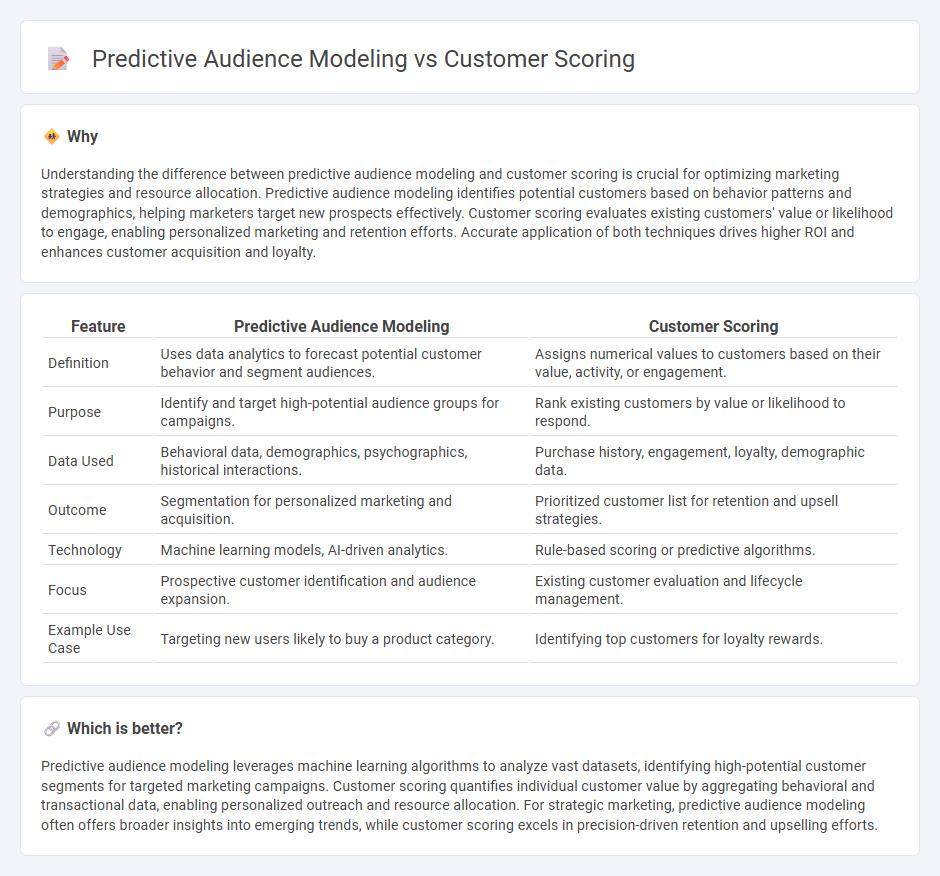
Predictive audience modeling leverages machine learning algorithms to identify potential customers by analyzing vast behavioral and demographic data sets, enhancing targeted marketing campaigns. Customer scoring assigns each individual a value based on their likelihood to engage or convert, streamlining resource allocation for personalized outreach. Explore how these strategies can transform your marketing effectiveness.
Why it is important
Understanding the difference between predictive audience modeling and customer scoring is crucial for optimizing marketing strategies and resource allocation. Predictive audience modeling identifies potential customers based on behavior patterns and demographics, helping marketers target new prospects effectively. Customer scoring evaluates existing customers' value or likelihood to engage, enabling personalized marketing and retention efforts. Accurate application of both techniques drives higher ROI and enhances customer acquisition and loyalty.
Comparison Table
| Feature | Predictive Audience Modeling | Customer Scoring |
|---|---|---|
| Definition | Uses data analytics to forecast potential customer behavior and segment audiences. | Assigns numerical values to customers based on their value, activity, or engagement. |
| Purpose | Identify and target high-potential audience groups for campaigns. | Rank existing customers by value or likelihood to respond. |
| Data Used | Behavioral data, demographics, psychographics, historical interactions. | Purchase history, engagement, loyalty, demographic data. |
| Outcome | Segmentation for personalized marketing and acquisition. | Prioritized customer list for retention and upsell strategies. |
| Technology | Machine learning models, AI-driven analytics. | Rule-based scoring or predictive algorithms. |
| Focus | Prospective customer identification and audience expansion. | Existing customer evaluation and lifecycle management. |
| Example Use Case | Targeting new users likely to buy a product category. | Identifying top customers for loyalty rewards. |
Which is better?
Predictive audience modeling leverages machine learning algorithms to analyze vast datasets, identifying high-potential customer segments for targeted marketing campaigns. Customer scoring quantifies individual customer value by aggregating behavioral and transactional data, enabling personalized outreach and resource allocation. For strategic marketing, predictive audience modeling often offers broader insights into emerging trends, while customer scoring excels in precision-driven retention and upselling efforts.
Connection
Predictive audience modeling leverages data analytics and machine learning algorithms to identify potential customer segments that are most likely to convert or engage. Customer scoring assigns quantitative values to individual audience members based on their predicted behaviors, enhancing targeted marketing strategies. Together, these techniques optimize campaign efficiency by prioritizing high-value prospects and personalizing outreach efforts.
Key Terms
**Customer Scoring:**
Customer scoring quantifies individual customer value using historical data, purchasing behavior, and demographic factors to segment and prioritize high-potential clients. It enables businesses to tailor marketing strategies, optimize resource allocation, and enhance customer retention rates effectively. Explore how customer scoring can transform your customer engagement and maximize ROI.
Lead Qualification
Customer scoring evaluates leads by assigning numerical values based on demographic and behavioral data to identify high-potential prospects for sales teams. Predictive audience modeling uses machine learning algorithms to analyze large datasets and predict which leads are most likely to convert, enhancing lead qualification precision. Explore how integrating these methodologies can optimize your lead qualification strategy for better sales outcomes.
Scorecard Metrics
Customer scoring leverages historical data to assign numeric values representing individual potential or risk, focusing on metrics like accuracy, precision, and lift to gauge model effectiveness. Predictive audience modeling employs advanced algorithms and diverse datasets to identify and segment high-value customer groups, optimizing engagement through metrics such as conversion rate and ROI. Explore detailed comparisons to enhance targeting strategies and maximize marketing impact.
Source and External Links
Customer Scoring: Definition, Methods, Use Cases - This article explores the definition, methods, and applications of customer scoring, highlighting its role in enhancing customer understanding and marketing ROI.
Better Decision Making with Customer Scoring - This feature allows businesses to evaluate and rank clients based on predefined criteria, enabling informed decision-making regarding client potential and risk.
What Is Customer Scoring and How Does It Work? - This resource explains how customer scoring works by assigning scores to customers based on company-defined criteria, facilitating personalized customer service and strategic objectives.
 dowidth.com
dowidth.com